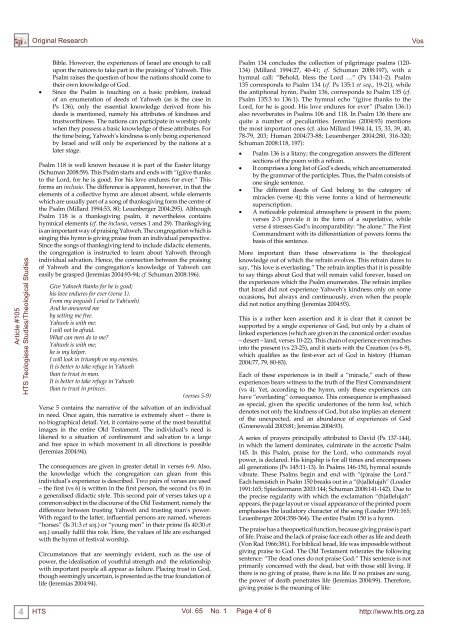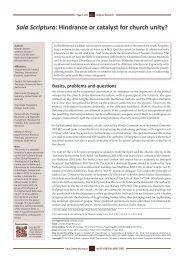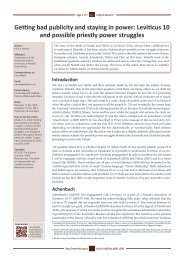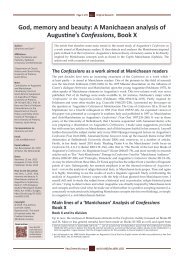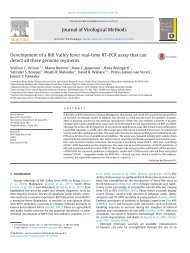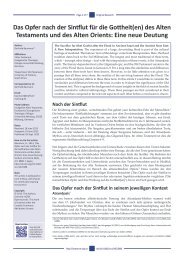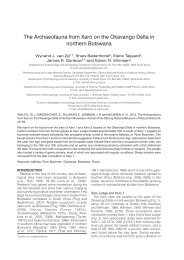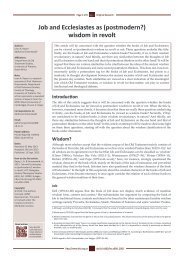THE PSALMS AS HYMNS IN A LITURGICAL CONTExT 1
THE PSALMS AS HYMNS IN A LITURGICAL CONTExT 1
THE PSALMS AS HYMNS IN A LITURGICAL CONTExT 1
You also want an ePaper? Increase the reach of your titles
YUMPU automatically turns print PDFs into web optimized ePapers that Google loves.
Original Research<br />
Vos<br />
Article #105<br />
HTS Teologiese Studies/Theological Studies<br />
Bible. However, the experiences of Israel are enough to call<br />
upon the nations to take part in the praising of Yahweh. This<br />
Psalm raises the question of how the nations should come to<br />
their own knowledge of God.<br />
• Since the Psalm is touching on a basic problem, instead<br />
of an enumeration of deeds of Yahweh (as is the case in<br />
Ps 136), only the essential knowledge derived from his<br />
deeds is mentioned, namely his attributes of kindness and<br />
trustworthiness. The nations can participate in worship only<br />
when they possess a basic knowledge of these attributes. For<br />
the time being, Yahweh’s kindness is only being experienced<br />
by Israel and will only be experienced by the nations at a<br />
later stage.<br />
Psalm 118 is well known because it is part of the Easter liturgy<br />
(Schuman 2008:59). This Psalm starts and ends with “(g)ive thanks<br />
to the Lord, for he is good. For his love endures for ever.” This<br />
forms an inclusio. The difference is apparent, however, in that the<br />
elements of a collective hymn are almost absent, while elements<br />
which are usually part of a song of thanksgiving form the centre of<br />
the Psalm (Millard 1994:53, 80; Leuenberger 2004:295). Although<br />
Psalm 118 is a thanksgiving psalm, it nevertheless contains<br />
hymnical elements (cf. the inclusio, verses 1 and 29). Thanksgiving<br />
is an important way of praising Yahweh. The congregation which is<br />
singing this hymn is giving praise from an individual perspective.<br />
Since the songs of thanksgiving tend to include didactic elements,<br />
the congregation is instructed to learn about Yahweh through<br />
individual salvation. Hence, the connection between the praising<br />
of Yahweh and the congregation’s knowledge of Yahweh can<br />
easily be grasped (Jeremias 2004:93-94; cf. Schuman 2008:196).<br />
Give Yahweh thanks for he is good;<br />
his love endures for ever (verse 1).<br />
From my anguish I cried to Yah(weh)<br />
And he answered me<br />
by setting me free.<br />
Yahweh is with me:<br />
I will not be afraid.<br />
What can men do to me?<br />
Yahweh is with me;<br />
he is my helper.<br />
I will look in triumph on my enemies.<br />
It is better to take refuge in Yahweh<br />
than to trust in man.<br />
It is better to take refuge in Yahweh<br />
than to trust in princes.<br />
(verses 5-9)<br />
Verse 5 contains the narrative of the salvation of an individual<br />
in need. Once again, this narrative is extremely short – there is<br />
no biographical detail. Yet, it contains some of the most beautiful<br />
images in the entire Old Testament. The individual’s need is<br />
likened to a situation of confinement and salvation to a large<br />
and free space in which movement in all directions is possible<br />
(Jeremias 2004:94).<br />
The consequences are given in greater detail in verses 6-9. Also,<br />
the knowledge which the congregation can glean from this<br />
individual’s experience is described. Two pairs of verses are used<br />
– the first (vs 6) is written in the first person, the second (vs 8) in<br />
a generalised didactic style. This second pair of verses takes up a<br />
common subject in the discourse of the Old Testament, namely the<br />
difference between trusting Yahweh and trusting man’s power.<br />
With regard to the latter, influential persons are named, whereas<br />
“horses” (Is 31:3 et seq.) or “young men” in their prime (Is 40:30 et<br />
seq.) usually fulfil this role. Here, the values of life are exchanged<br />
with the hymn of festival worship.<br />
Circumstances that are seemingly evident, such as the use of<br />
power, the idealisation of youthful strength and the relationship<br />
with important people all appear as failure. Placing trust in God,<br />
though seemingly uncertain, is presented as the true foundation of<br />
life (Jeremias 2004:94).<br />
Psalm 134 concludes the collection of pilgrimage psalms (120-<br />
134) (Millard 1994:27, 40-41; cf. Schuman 2008:197), with a<br />
hymnal call: “Behold, bless the Lord …” (Ps 134:1-2). Psalm<br />
135 corresponds to Psalm 134 (cf. Ps 135:1 et seq., 19-21), while<br />
the antiphonal hymn, Psalm 136, corresponds to Psalm 135 (cf.<br />
Psalm 135:3 to 136:1). The hymnal echo “(g)ive thanks to the<br />
Lord, for he is good. His love endures for ever” (Psalm 136:1)<br />
also reverberates in Psalms 106 and 118. In Psalm 136 there are<br />
quite a number of peculiarities. Jeremias (2004:93) mentions<br />
the most important ones (cf. also Millard 1994:14, 15, 33, 39, 40,<br />
78-79, 203; Human 2004:73-88; Leuenberger 2004:280, 316-320;<br />
Schuman 2008:118, 197):<br />
• Psalm 136 is a litany; the congregation answers the different<br />
sections of the poem with a refrain.<br />
• It comprises a long list of God’s deeds, which are enumerated<br />
by the grammar of the participles. Thus, the Psalm consists of<br />
one single sentence.<br />
• The different deeds of God belong to the category of<br />
miracles (verse 4); this verse forms a kind of hermeneutic<br />
superscription.<br />
• A noticeable polemical atmosphere is present in the poem;<br />
verses 2-3 provide it in the form of a superlative, while<br />
verse 4 stresses God’s incomparability: “he alone.” The First<br />
Commandment with its differentiation of powers forms the<br />
basis of this sentence.<br />
More important than these observations is the theological<br />
knowledge out of which the refrain evolves. This refrain dares to<br />
say, “his love is everlasting.” The refrain implies that it is possible<br />
to say things about God that will remain valid forever, based on<br />
the experiences which the Psalm enumerates. The refrain implies<br />
that Israel did not experience Yahweh’s kindness only on some<br />
occasions, but always and continuously, even when the people<br />
did not notice anything (Jeremias 2004:93).<br />
This is a rather keen assertion and it is clear that it cannot be<br />
supported by a single experience of God, but only by a chain of<br />
linked experiences (which are given in the canonical order: exodus<br />
– desert – land, verses 10-22). This chain of experience even reaches<br />
into the present (vs 23-25), and it starts with the Creation (vs 6-9),<br />
which qualifies as the first-ever act of God in history (Human<br />
2004:77, 79, 80-83).<br />
Each of these experiences is in itself a “miracle,” each of these<br />
experiences bears witness to the truth of the First Commandment<br />
(vs 4). Yet, according to the hymn, only these experiences can<br />
have “everlasting” consequence. This consequence is emphasised<br />
as special, given the specific undertones of the term hsd, which<br />
denotes not only the kindness of God, but also implies an element<br />
of the unexpected, and an abundance of experiences of God<br />
(Groenewald 2003:81; Jeremias 2004:93).<br />
A series of prayers principally attributed to David (Ps 137-144),<br />
in which the lament dominates, culminate in the acrostic Psalm<br />
145. In this Psalm, praise for the Lord, who commands royal<br />
power, is declared. His kingship is for all times and encompasses<br />
all generations (Ps 145:11-13). In Psalms 146-150, hymnal sounds<br />
vibrate. These Psalms begin and end with “(p)raise the Lord.”<br />
Each hemistich in Psalm 150 breaks out in a “(h)allelujah” (Loader<br />
1991:165; Spieckermann 2003:144; Schuman 2008:141-142). Due to<br />
the precise regularity with which the exclamation “(h)allelujah”<br />
appears, the page layout or visual appearance of the printed poem<br />
emphasises the laudatory character of the song (Loader 1991:165;<br />
Leuenberger 2004:358-364). The entire Psalm 150 is a hymn.<br />
The praise has a theopoetical function, because giving praise is part<br />
of life. Praise and the lack of praise face each other as life and death<br />
(Von Rad 1966:381). For biblical Israel, life was impossible without<br />
giving praise to God. The Old Testament reiterates the following<br />
sentence: “The dead ones do not praise God.” This sentence is not<br />
primarily concerned with the dead, but with those still living. If<br />
there is no giving of praise, there is no life. If no praises are sung,<br />
the power of death penetrates life (Jeremias 2004:99). Therefore,<br />
giving praise is the meaning of life:<br />
4<br />
HTS<br />
Vol. 65 No. 1 Page 4 of 6<br />
http://www.hts.org.za


